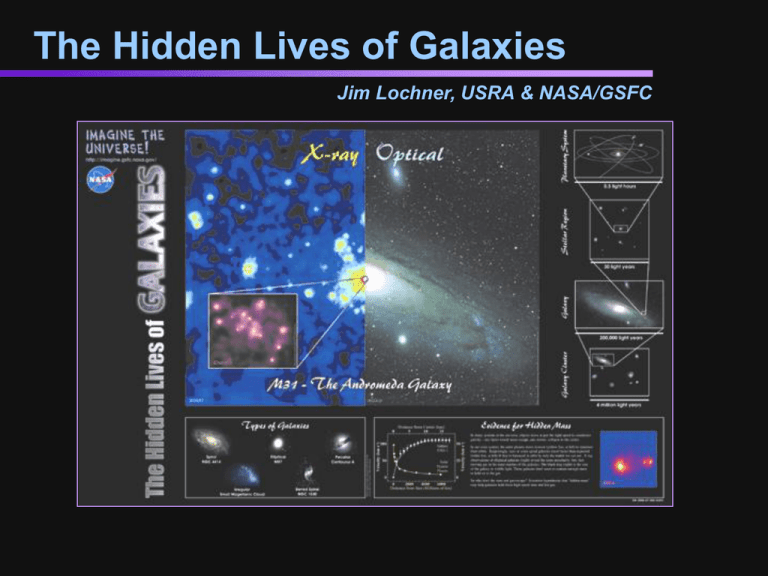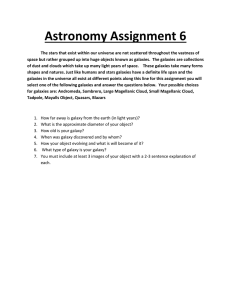The Hidden Lives of Galaxies Jim Lochner, USRA & NASA/GSFC
advertisement

The Hidden Lives of Galaxies Jim Lochner, USRA & NASA/GSFC What is a Galaxy ? Solar System Distance from Earth to Sun = 93,000,000 miles = 8 light-minutes Size of Solar System = 5.5 light-hours What is a Galaxy? Stellar Region Sun (solar system too small to be seen on this scale) 30 light-years What is a Galaxy? Galaxy Sun’s Stellar Region a massive collection of stars, gas, and dust kept together by gravity 200,000 light-years What is a Galaxy? If our solar system was the size of a cell in the human body, our galaxy would still measure over one mile across. Types of Galaxies Spiral disk-like appearance with arms of stars and Barred Spiral dust forming a spiral similar to spirals but pattern with a bright bar of Elliptical stars and gas through elliptically-shaped, the center with less gas and dust Irregular than spirals; no disk neither elliptical noror “arms”in shape; gas and spiral Peculiar dust as in spirals noof the above types, often due to distorted form ofbut one defined collision“arms” with another galaxy or similar catastrophic event The Hidden Lives of Galaxies Galaxy Formation Galaxies form from the primordial density fluctuations that arise after the big bang and grow under inflation. These density fluctuations form filaments, and galaxies form in knots along the filaments. Spirals vs. Ellipticals Final type of galaxy depends on initial rate of star formation: - If stars form quickly, then galaxy becomes elliptical. Stars form within initial distribution of gas,and follow their initial orbits. - If stars form later, the gas has time to collapse into a disk. Most stars from within the disk. The galaxy becomes a spiral. Formation via Galaxy Mergers In clusters, galaxies can pass close to one another. • Galaxies can become distorted, and often merge. • Mergers often lead to giant elliptical galaxies at the heart of large clusters. Spirals in Grazing Encounter Antennae Galaxies “Invisible” Light from Galaxies Electromagnetic Spectrum “Invisible” Light from Galaxies “Invisible” Light from Galaxies X-ray Objects in Galaxies: • stars • supernova remnants • X-ray binaries • hot gas Hidden Mass in Galaxies This X-ray image of an elliptical galaxy reveals hot, fastmoving gas even in the outer reaches of the galaxy. The visible mass of the galaxy is insufficient to hold onto it. (The dark circle shows the size of the galaxy when photographed in visible light. The X-ray image shows mass far outside the visible image.) Hidden Mass in Galaxies So, we have a Problem: • This gas gives off X-rays, which means it’s hot! • Hot gas moves at high velocities - we can measure and confirm this • The velocity of the gas is greater than the escape velocity of the galaxy, if we calculate the galaxy’s mass by adding up all the mass we can see at all wavelengths of light • So why hasn’t the gas escaped? There must be more mass we can’t see! Hidden Mass in Galaxies Another way to look at the problem: We can determine the mass of an object by measuring the motion of bodies in orbit around it. Newton’s Second Law: F = Force of Gravity a = acceleration due to circular motion F ma GMm mv 2 r r 2 Hidden Mass in Galaxies From previous slide, we have Newton’s Second Law of Motion assuming a gravitational force and acceleration due to circular motion: 2 GMm mv 2 r r Simplifying gives: GM v r 2 So, if GM is constant, then velocity is proportional to the inverse square root of distance. For example ... Hidden Mass in Galaxies Rotation Curve - A Plot of Object Velocity vs. Distance Our Solar System Activity #6a: Evidence for Hidden Mass There are ____ nine solar system planets presented on the graph. The planets, from the closest to the sun to the Mercury, Venus, Earth, Mars, Jupiter, furthest, are ___________________________________ ______________________________. Saturn, Uranus, Neptune, and Pluto Using the graph, the velocities of the solar system planets, from the lowest value to the highest value, are _____________________ approximately 48, 35, 30, _________________________. 24, 13, 10, 7, 5, and 4 km/sec Using the graph, the distances of the planets from the Sun are, from least to greatest, ____________________________________ 0, 110, 150, 250, 800, 1500, 2800, 4500, and ______________. 6000 million km In general, the further a planet is from the sun the ______ slower its velocity. The closer a planet is to the sun ______ faster its velocity. Hidden Mass in Galaxies Rotation Curve - A Plot of Object Velocity vs. Distance Our Solar System v 1/ r Hidden Mass in Galaxies The previous plot showed data for planets in our solar system, illustrating the equation: GM v r 2 If we solve for M: M v r /G 2 We can use real data (the distances and velocities of the planets) and the fact that G = 6.67 x 10-11 m3/kg-s2 to verify that the central mass, M, remains constant.. Activity 6b, part 1 Planet Velocity (km/s) Earth Distance from Sun (km) 8 1.5 x 10 29.8 2.0 x 1030 Jupiter 7.8 x 108 13.1 2.0 x 1030 5.4 2.0 x 1030 Neptune 9 4.5 x 10 Mass (kg) Hidden Mass in Galaxies What does this have to do with Galaxies??? If we measure the distance and velocity of objects (eg., stars) orbiting in a galaxy, we’d expect them to obey the same laws. As distance from the center of the galaxy increases, we should get to a point where almost all of the galaxy’s mass is inside the orbit of the furthest objects. At this point, the central mass would be practically constant, and we would expect a rotation curve similar to that for our solar system. Hidden Mass in Galaxies What weexpected expect for a galaxywith if allactual the mass was Compare velocities velocities concentrated in the central region. Hidden Mass in Galaxies If we take the same equation we used for the solar system: M v r /G 2 and use the actual distances and velocities observed for this galaxy, we can calculate the enclosed mass at various distances from the galaxy’s center. (Remember that G = 6.67 x 10-11 m3/kg-s2 ) Activity 6b, part 2 Distance (kpc) Velocity (km/s) Mass (kg) 5.0 95.0 2.1 x 1040 10.0 110.0 5.6 x 1040 15.0 110.0 8.4 x 1040 Hidden Mass in Galaxies What Happened?!?!? The central mass never becomes constant, as it did for the Solar System. The fact that the mass is still increasing means we haven’t yet reached a distance where all the mass is contained inside that orbit. But we’ve plotted all the matter we see! There must be Missing Mass!! Hidden Mass in Galaxies Hot Gas and Rotation Curves show: • Gas and objects move at velocities greater than can be accounted for from the gravitational effect of the visible mass of the galaxy. • From these observations we deduce that the visible mass accounts for only 10 % of the total mass of the galaxy. • Recent results from WMAP show ordinary matter makes up only 4% of the universe! Candidates for the Hidden Mass • Hydrogen Gas – Very abundant, but not enough detected • MACHOs (Massive Compact Halo Objects) – E.g. Black Holes, Neutron Stars, Brown Dwarfs – Not enough of them • WIMPs (Weakly Interacting Massive Particles) – E.g. Exotic subatomic particles – The best candidate theoretically, but not yet observed. The Hidden Lives of Galaxies Presentation available at http://imagine.gsfc.nasa.gov/docs/teachers/galaxies/galaxies.html





